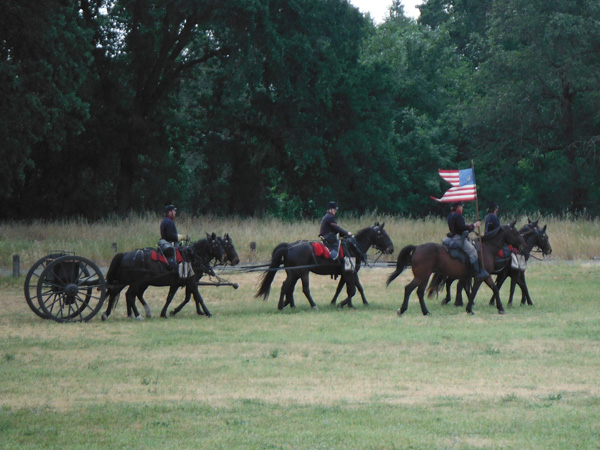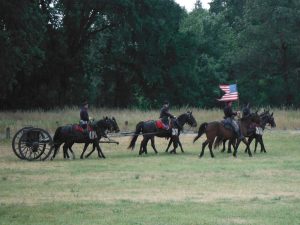CHAS: The California Historical Artillery Society-Part 2
 Continuing my interview with Judith Boling from the California Historical Artillery Society …
Continuing my interview with Judith Boling from the California Historical Artillery Society …
MG: What is the most common question asked during your demonstrations?
JB: “How does CHAS train the horses to stand the gunfire and commotion on the battlefield?” (apparently, I am not very original in wondering …).
MG: How far “East” have you been? What sort of interactions did you have with other artillery companies?
JB: A group of members of California Historical Artillery Society went to Gettysburg for the 150thanniversary of that battle in 2013, but they were unable to bring the horses.
We frequently interact with other artillery batteries throughout California, falling in with them when we have a low turnout at events. We also have artillerymen from other batteries fall in with us when they are visiting from other parts of the state or country.
 MG: What kind of “horse sense” should a visitor to your artillery exhibit show?
MG: What kind of “horse sense” should a visitor to your artillery exhibit show?
JB: Stay calm. Don’t make furtive movements. Never approach the horses on your own. Always seek out a club member to accompany you to visit the horses
MG: How can the general public get involved in helping support the living history you portray and the great work you do with former trotting racehorses?
JB: The public is cordially invited to sponsor one or more horse(s) to help with the costs of caring for them. The sponsorship form is available on our website, www.warhorse.org
All of your readers in Northern California may want to travel to Fresno on August 20 & 21, 2018 to see the teams in action. The Fresno Historical Society will be hosting Civil War Revisited that weekend. Additional information and directions to the event may be found at www.info.valleyhistory.org.
MG: Why exactly did your group choose to portray the 3rdU.S. Artillery?
JB: California Historical Artillery Society portrays the 3rdU.S. Artillery, Batteries L & M, consolidated.
The 3rdU.S. Artillery of the mid-nineteenth century had been sent west to fight in the Mexican War. At the conclusion of that war, they moved into California and were posted in Monterey and San Francisco. After the Civil War had begun, Batteries L & M, consolidated returned to the east coast and participated in many major battles.
It was a natural fit for a field artillery reenacting group, then based in Salinas, California, to select this impression.
 MG: A word about Dennis Winfrey?
MG: A word about Dennis Winfrey?
JB: Dennis Winfrey is a charter member of CHAS, and was our benefactor for more than twenty years. He purchased most of our equipment and the horses. Dennis had a vision of CHAS eventually portraying the entire regiment, infantry, cavalry, and artillery, along with all of the support units.
MG: Is there anything else you would like to tell the readers of Emerging Civil War?
JB: CHAS always welcomes new recruits. Membership dues for the first year are $15.00 for an individual and $30 per family living in the same household. Membership applications can be found on our website, www.warhorse.org.
 A reenacting battlefield is a dangerous place. Therefore, CHAS requires a person to be 14 years or older to be part of our military impression. In addition to the field artillery impression with cannoneers and horse team drivers, we also have signal corps, ambulance, and artificer impressions.
A reenacting battlefield is a dangerous place. Therefore, CHAS requires a person to be 14 years or older to be part of our military impression. In addition to the field artillery impression with cannoneers and horse team drivers, we also have signal corps, ambulance, and artificer impressions.
The signal corps use flags and fire to relay orders to officers across the battlefield.
The ambulance impression includes long line driving a team of horses, as well as ambulance attendants who take the “injured” off the battlefield to a field hospital.
The artificers were trained blacksmiths, farriers, coopers, and cobblers. They were responsible for repairing all artillery equipment and tack, as well as keeping the horses shod. CHAS owns a traveling forge from the era, one of only a handful left.
We understand that military life isn’t for everyone. CHAS also offer membership for men, women, and children wishing to portray townspeople, merchants, artisans, newspaper correspondents, and people working for and with soldier relief organizations such as The U.S. Sanitary Commission, and The Christian Commission. Children 13 years and younger must participate as civilians.
MG: Thanks so much for your time, and much good luck in the future. I hope to see your group in October.
* * *
One more thing I was curious about was how to help and encourage groups such as CHAS. Their website contains several suggestions, but the one I like best is “Meet the Horses.” There are four donation options, all of which offer the opportunity to get to know some of the “mighty steeds” of the California Historical Society:
- $25.00 Donation Package includes a Personalized Certificate of Appreciation and a color photo of your sponsored horse
o $75.00 Donation Package includes the above plus a free pass to any CHAS event
o $100.00 Donation Package (supports 1 horse for 1 month) includes the above plus two free passes to any CHAS event
- $1,200 Donation Package (supports 1 horse for 1 year) includes all of the above plus 4 free passes and recognition on the CHAS website for a year.
There are organizations nationwide that seek to give the public an accurate portrayal of the men, women, equipment, and horses that have represented our country in war, from the colonial era forward. CHAS is doing double duty by not only portraying Union artillery and medical corps but also by saving horses. These folks deserve our support. If you are in California next month, I hope to see you in Fresno, and if you are on my Christmas List, be prepared to get a horse photo.

Thanks for the interview very interesting. I have never seen a description of the horse breeds needed for artillery service. I think I’ve read that the Ordnance Dept was responsible for equine medicine, or at least the equipage needed for maintenance of horses in the field. These kind of logistics issues don’t seem to interest historians and I suppose their audiences.
Well, they interest me, and I’m a historian. I think many forget that, for everybody concerned, the Civil War was merely four years out of a lifetime. Sometimes it was the end of that lifetime. I think it falls on us all to try to understand not only those four years, but the time period in which the lifetimes took place. This is one of the things that drives me, anyway.
Scott–it was late when I replied to your comment, and I forgot my manners–thanks for your comment, and for your insight into the mindsets of many other historians. Again, thank you.
Agree. In his Artillerist’s Manual John Gibbon included an interesting section on selecting artillery horses.
John–thanks for the addition of this resource. There is just something about horses at a reenactment or history demonstration. Here in CA we have many ranchos and missions, and our historical groups really try to include horses–upon which the state depended for many years–in their demonstrations.
I grew up driving a pair of horses pulling a wagon or a plow. My father farmed and ranched 19th century style. I have never forgotten the experience. Thanks for the reminder.
Rosemary–thanks for the comment. I had an uncle in Kansas who farmed in a similar manner, since he ran stock rather than planted crops. This brought back memories to me as well.